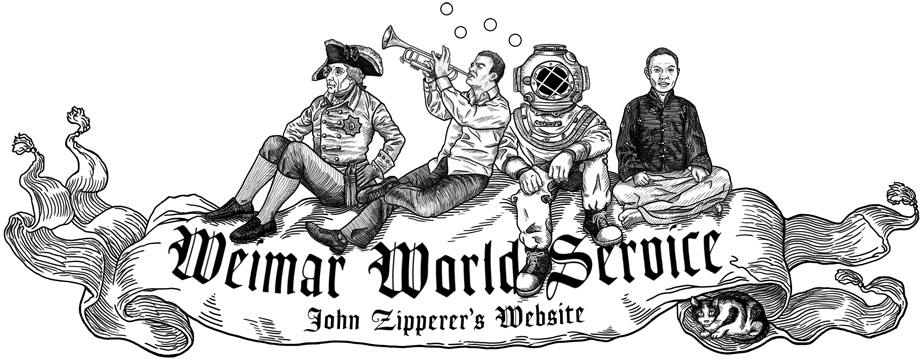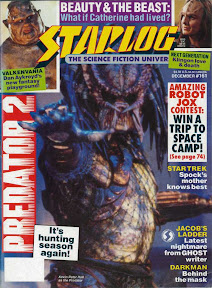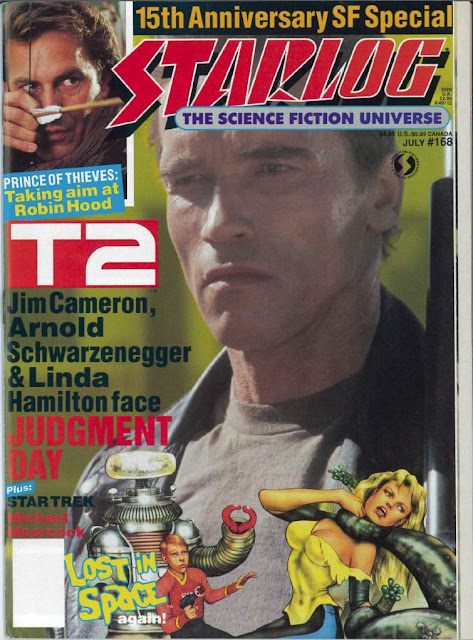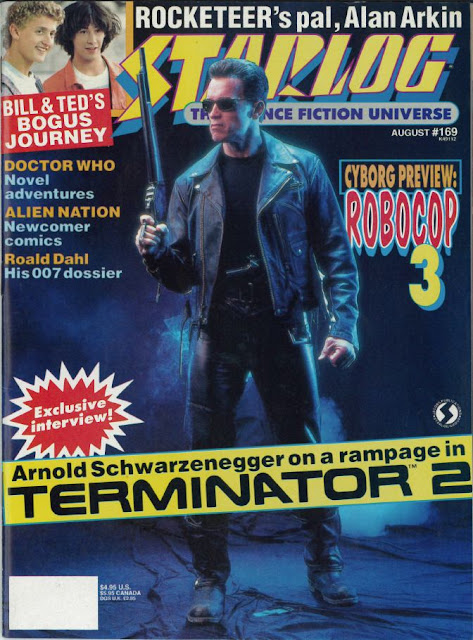| |
|
STARLOG: THE
ENTIRE RUN |
Starlog #161, December 1990: To Catch a Predator 2
The first Predator movie kind of came out of nowhere to become a cult hit. But the media was prepared for the sequel, and it got more attention than its predecessor. Thus, a Predator cover on Starlog.
Also note that this issue Starlog’s cover price jumps 55 cents, from $3.95 to $4.50. I know, inflation blah blah blah. But still, the magazine has been at a standard 76 pages (excluding special extra-page issues) since #94 back in May 1985 – 68 issues ago. The paper quality is much better than it was five years earlier, but it’s the same total number of pages, the same amount of color pages in the overall package, and it costs $4.50 instead of the $2.95 that #94 cost.
But don’t complain too much. Within half-a-year or so, the magazine will finally upgrade its page count and color situation, resuming its march to ever-more of both.
Starlog #161
76 pages (including covers)
Cover price: $4.50
Photo caption of the month: “Pete Martell stands out as the most normal Twin Peaks resident – just don’t let him near a percolator.”
The rundown: A powerful-looking Predator star is on the cover, while Valkenvania’s Demi Moore is featured on the contents page. Reader letters in Communications include praise for the Michael Ironside interview in #155, give decidedly mixed reactions to Total Recall, and attempt to be as weird as the Philip K. Dick interview it's referencing; and David McDonnell’s Medialog announces a sequel to be called Bill & Ted Go to Hell, plus other genre news.
Marc Shapiro previews the Dan Akroyd-John Candy-Demi Moore fantasy film Valkenvania (about which Akroyd says, “I don’t know why Starlog would want to cover this movie. It’s definitely not science fiction.” Fine. I said it was fantasy.); new video releases (Jetsons: The Movie, Total Recall, Back to the Future Part III, etc.) are announced in David Hutchison’s Videolog column; Robert Pegg profiles actor Jack Nance, veteran of David Lynch productions such as Eraserhead and Twin Peaks; Robert Greenberger interviews actress Suzie Plakson, who portrayed the Klingon K’Ehleyr in Star Trek: The Next Generation; in the second part of his talk with writer George R.R. Martin, Edward Gross explores how the series dealt with star Linda Hamilton’s decision to dial down her involvement with Beauty & the Beast; Michael Vance and Bradley H. Sinor talk with veteran science-fiction author Hal Clement; and Dan Yakir checks in with writer Bruce Joel Rubin to talk about his new movie Jacob’s Ladder (and he also discusses Ghost and Brainstorm).
The Fan Network pages include Lia Pelosi’s fan club directory, convention calendar, and some very short news bits on SF music parodies and a non-fiction book by Edward Gross exploring aspects of Beauty & the Beast; in the cover story, Marc Shapiro unveils this season’s Predator (and includes this comment by writer Jim Thomas: “I think Predator vs. Alien is a good idea that will probably never happen. ... My personal favorite would be to have the Predator beat the crap out of the Teenage Mutant Ninja Turtles”), with a sidebar chat with director Stephen Hopkins; Shapiro also explores TSR’s first move into the comics publishing business, with a new Buck Rogers title; actor Liam Neeson tells Kyle Counts about his role as the star of Darkman; Tom Weaver interviews actress Jane Wyatt, the veteran who portrayed Spock’s mother (and whom I always mix up with Jane Wyman, Ronald Reagan’s first wife); a two-page Tribute section includes Kim Howard Johnson’s remembrance of actor Jack Gilford and Python Graham Chapman, and Tim Ferrante provides actor Jock Mahoney’s obituary; Jean Airey and Laurie Haldeman, who chronicled everything Blake’s 7-ish a while back, return with a complete episode guide to the Robin of Sherwood TV series; Kerry O’Quinn gets all misty about Niagara Falls in his From the Bridge column; and David McDonnell’s Liner Notes column announces Mike Fisher’s new computer-drawn “Creature Profile” comic panel that will appear in the magazine for a number of years.
“There’s a moment when the cameras are rolling and before the director has called ‘action’ that you’re waiting. You’re not yet committed to the scene and you’re waiting for the cue and you’re in a very vulnerable kind of moment. It’s an intense pressure and concentration. And David [Lynch] will use that moment and start talking to you and give you verbal cues to the scene like ‘wrapped in plastic’ and you’ll be reacting to what he’s saying and do it on the spot. He has caught you, caught you unawares. It’s really neat and it’s really personal, a kind of intimate thing.”
–Jack Nance, actor, interviewed by Robert Pegg: “Deceptive Appearances”
|
Starlog #162, January 1991: LeVar Burton in the Spotlight
Star Trek: The Next Generation’s Geordi La Forge is one of the characters that started out on that show in a relatively ignored status, but who grew and grew as the show went on, the cast evolved, and as actor LeVar Burton proved he had the acting chops to be more than a navigator saying, “Yes, Captain!” when told to “Engage!”
Worf’s role also grew dramatically throughout ST:TNG (and Deep Space Nine). It makes you figure that Denise Crosby was way too impatient to be complaining about a lack of opportunity with her Tasha Yar character in the middle of the first year. Clearly, her character would have expanded and matured and gotten her day in the sun.
A little magazine business talk: This is the second issue Starlog has published since increasing its cover price (from $3.95 to $4.50). It doesn’t add pages (yet; that’s coming), but it does add one color to its black-and-white pages (the non-glossy paper pages). So these pages are (in publishing lingo) B&W +1. It’s a nice addition, though Starlog – as Starlog is wont to do – overdoes it, larding many of these pages with the extra color (which changes each issue, sometimes a light green, sometimes a blue, sometimes – eek – a yellow).
It’s kind of interesting that the magazine added this on the second issue with the higher price. Usually, you add it on the first issue (or sometimes the last issue of the lower price), so the reader isn’t ever left with that feeling of shelling out more money and getting nothing for it. Who knows; maybe there was a mixup in the executive suite of Starlog and they raised the cover price before they had all their ducks in a row. But even if the addition of color is a delayed improvement, it’s still an improvement. And in a few issues, they’ll even throw in four more pages, so get out your party dress!
Starlog #162
76 pages (including covers)
Cover price: $4.50
Some classified ads are just more interesting than others. Case in point: “AT LAST, A guide you can buy about a gravity driven mother ship. Write for free information ...”
The rundown: LeVar Burton as Geordi La Forge is the cover man; meanwhile, a somewhat meaner character, the Predator, is featured on the contents page. Communications letters rip apart RoboCop 2, genre journalist Paul Mandell gives an extended expert response to Steve Swires’ interview with Ray Harryhausen’s producing partner Charles Schneer (in Starlogs #150-152), plus Mike Fisher’s Creature Profile comic features The Ymir; and David McDonnell’s Medialog column informs us of planned sequels to Moontrap, Tales from the Darkside: The Movie, Beastmaster, and The Terror Within.
Marc Shapiro interviews LeVar Burton about his role as the chief engineer on Star Trek: The Next Generation (Burton notes, “Making Georgie Chief Engineer and moving him to another part of the ship was great because it gave him a responsibility that’s integral to each and every story”); David Hutchison’s Videolog column notes the latest genre video releases, including the apparently much-hated Robocop 2; William B. Thompson profiles writer Robert Jordan (The Great Hunt, The Eye of the World, and others); Steve Swires talks with 79-year-old director Val Guest about the Quatermass films and other productions in his career; Marc Shapiro interviews actor Kent McCord, who discusses Predator 2, Adam 12, and Galactica 1980 (including how the show morphed from a planned riff on The Day the Earth Stood Still to a show in which alien kids played baseball); Robert Pegg talks to screenwriter Caroline Thompson about Edward Scissorhands; and the Fan Network pages include Lia Pelosi’s directory of fan publications and clubs (this is your chance to get in touch with West Germany’s Knight Rider fan club).
Marc Shapiro profiles Quantum Leap star Dean Stockwell (“I always liked the idea that Al was the equivalent of a desk sergeant who sends the other cops out to arrest the bad guys”); Bill Warren previews She-Wolf, a TV series from former Starlog correspondents Lee Goldberg and William Rabkin (with a sidebar in which the two discuss writing for Beauty & the Beast); Dan Yakir gets Patrick Swayze to discuss his role as Ghost’s ghost; Mark Phillips interviews actor Liam Sullivan, who guest starred in the original Star Trek episode “Plato’s Stepchildren” (which featured the first interracial kiss on slow-to-the-gate American television); continuing the magazine’s coverage of the 1960’s TV series Land of the Giants, Mark Phllips profiles actor Don Matheson (with a sidebar chat with Giants writer Esther Mitchell); After he made his mark as Benny in L.A. Law, Larry Drake starred as the villain in Darkman, which he discusses with Kyle Counts; in his From the Bridge column, Kerry O’Quinn goes back home for a Texas-sized Star Trek convention, including taking George Takei out for bar-b-que; and David McDonnell’s Liner Notes column tells us about the revived Starlog Festivals.
“The last sequence of the film was the confrontation with the creature in Westminster Abbey. It was imperative that Jack [Warner] – who had been right through the picture as Inspector Lomax – was in that final scene. Yet, the night before we shot it, the assistant director told me, ‘You can’t have Jack Warner tomorrow. [Producer] Tony Hinds won’t pay his salary for the day.’ I said, ‘You must be joking. It’s the last scene in the film. This man has tracked down the creature through the whole movie. He is the one person who must be there.’ ‘Tony isn’t going to pay for him,’ the assistant director said. ‘He’s off the pay list.’ I told him, ‘You go to Tony, and tell him I will personally pay Jack’s salary for the day. He has to be on set tomorrow.’”
–Val Guest, director, interviewed by Steve Swires: “The Quatermass Conductor”
|
Harry & the Hendersons: Starlog #163, February 1991
Does anyone remember the short-lived TV series Harry & the Hendersons? Did you know that Scott Baio was one of the directors of this show’s episodes? Yes? No?
Doesn’t matter. The syndicated series, which was based on a 1987 movie of the same name starring John Lithgow, lasted 72 episodes before being shown the door. Whether you liked or disliked this show, it must still cause you alarm that ALF lasted an entire season longer than Harry & the Hendersons. Just pointing that out.
This issue Starlog publishes its annual postal statement of ownership and circulation. The total paid circulation for the issue closest to the statement's filing deadline is listed as 171,137 (up from the previous year's 160,739, continuing a slow multi-year increase), including the number of paid subscriptions of 9,567 (also up, from 8,978 last year).
Starlog #163
76 pages (including covers)
Cover price: $4.50
Correct me if I'm wrong: Technically, Kevin Peter Hall has a first-and-only record-setting achievement this month. As the actor-in-the-monster-suit for both Harry & the Hendersons and the Predator movie, he appears twice on this cover, as different characters. (Note the Predator's pretty face in the upper right-hand corner of the cover. No, not the left; Gates McFadden was in fact played by Gates McFadden.)
The rundown: Kevin Peter Hall, who for a while was the go-to guy for tall-creature acting, is featured on the cover in his harry Harry (sans Hendersons) guise; and a blast from the past – E.T. – is on the contents page; the Communications section is kicked off with a long letter urging science-fiction fans to take environmentalism seriously, while other readers show how seriously they take Star Trek: The Next Generation, Lost in Space, and even android definitions, while Mike Fisher’s Creature Profile features King Kong; and David McDonnell’s Medialog column recounts the many failed efforts to resurrect Alien Nation.
Kyle Counts interviews Lost in Space star Bill Mumy, who discusses that series as well as his efforts to create a reunion show; David Hutchison’s Videolog column notes the releases of Total Recall, Back to the Future Part III, and other genre titles; Duane S. Arnott contributes his first article to Starlog, an interview with actor Robert Brown, who portrayed Lazarus in the original Star Trek episode “The Alternative Factor”; Desire Gonzales talks with actor Ritch Brinkley, whose role as Beauty & the Beast’s William the Cook was a bit of a misnomer, because “you never saw me cook so much as a piece of bread” (he also discusses his role as Carl the cameraman on Murphy Brown); T.W. Knowles II contributes a Q&A with novelist Elizabeth Ann Scarborough, who uses themes in her books from her time as a nurse in the Vietnam War; and Ian Spelling checks in with actress Gates McFadden, who discusses returning to Star Trek: The Next Generation (and who appears to be as clueless to her exit-and-return as is the audience).
The Fan Network pages include Patrick Daniel O’Neill’s report on the BBC’s attempt to recover lost video of Doctor Who episodes, plus Lia Pelosi’s directory of Doctor Who fan clubs; Marc Shapiro interviews “The Man in the Monster Suits,” Kevin Peter Hall, who talks about Harry & the Hendersons and Predator 2; Jean Airey talks with director and producer Vere Lorrimer about his efforts to continue and then kill Blake’s 7; Industrial Light & Magic effects supervisor Dennis Muren talks to John Stanley about creating special effects for Star Wars: The Empire Strikes Back, The Abyss, and others; in part two of Steve Swires’ interview with director Val Guest, the 79-year-old Guest talks about working with Woody Allen, among others; Dan Yakir speaks with director Adrian Lyne about Jacob’s Ladder; Kerry O’Quinn’s From the Bridge column sort-of reviews Michael Crichton’s book Travels; and in his Liner Notes column, editor David McDonnell lists the winners of a number of recent give-away contests.
“William Shatner is a sweetheart. He loves to laugh. Not the stiff, forced Nimoy guffaw, but a man who sees the odd part of life. Humor is his friend. He seems to be poking fun at himself more than others. A very likable fellow. As the intellectual type, Leonard Nimoy was somewhat removed, much like his acting, although a decent man of conscience.”
–Robert Brown, actor, interviewed by Duane S. Arnott: “Lazarus Rises Again”
|
Dan Aykroyd's Nothing But Trouble: Starlog #164, March 1991
Valkenvania, the Dan Aykroyd/Demi Moore/Chevy Chase fantasy comedy, has been renamed Nothing But Trouble and relaunched on the cover of this issue of Starlog. It’s not exactly the most pleasant cast of characters on the cover; you know it’s an odd collection when Edward Scissorhands (upper left corner) is the most normal “person” on your cover. But that’s genre publishing!
BTW, in an interview with the movie’s director, Aykroyd, inside this issue, the Saturday Night Live alum recalls giving the script to Warner Brothers. “They said, ‘Fine, we want to make this movie with you and John Candy.’ I said, ‘Fine. I want to play the judge and the banker.’ They said, ‘How about Chevy Chase as the banker?’ I said, ‘Great!’ He said ‘Great!' Everybody said, ‘Great!’ Then, we kind of looked at each other and said, ‘OK, who’s going to direct?’ And I thought to myself, ‘If I say I don't have a director at this point, it’s going to take months to find somebody,’ so I just blurted out, ‘I’ll do it.’”
Starlog #164
76 pages (including covers)
Cover price: $4.50
Reading through this issue, one notes that a number of Starlog family publications are chugging along. The licensed magazine Star Trek: The Next Generation is working on its fourth season, All-Star Action Heroes has its third edition, as does Comics Scene Spectacular (there would soon be a Starlog Spectacular and a Fangoria Horror Spectacular), etc. Of note (and editor David McDonnell does note it in his editorial) is the release of the 100th issue of Fangoria, the sister magazine that almost didn’t survive. It had a rough time (legally and in terms of sales) getting out of the gates in 1979, until the editors went with their guts and made it a full-fledged horror magazine and not a fantasy-horror-science-fiction hybrid. It was reportedly struggling again around issue #50, after both editors (“Uncle Bob” Martin and David Everitt) left and sales were soft, so Starlog editor David McDonnell took over editing chores (while he edited Starlog and numerous other titles; I really don’t know how he did it) for a little more than a year while he groomed future Fango editor Tony Timpone, who would go on to helm Fangoria for a quarter century – until early 2010, in fact.
All of that’s a long-winded way of saying that Fangoria reaching its 100th issue is a big deal. And it celebrates with a very good, special 100-page issue. As I write this (in 2010), Fangoria is nearing its 300th issue. It never would have gotten there if Starlog’s editor hadn’t stepped in and supported it when it was in danger of dying.
The rundown: Dan Aykroyd and John Daveikis are in fat-baby suits on the cover, while Jack Rickard’s illustration of the Creature from the Black Lagoon is on the contents page. In the Communications section, readers write about Beauty & the Beast, Land of the Giants, and Star Trek, plus Mike Fisher’s Creature Profile features the Creature from the Black Lagoon; and David McDonnell’s Medialog reports on a whole slew of sequels, including a planned sequel to The Punisher before the first movie has even been released.
Interplanetary correspondent Michael Wolff is back with another exploration of a popular genre concept, this time looking at Frankenstein throughout the years (as illustrated by George Kochell); Edward Gross hears Kenneth Johnson’s unrealized plans for the continuing adventures of Alien Nation; the Fan Network pages feature Lia Pelosi’s fan club directory and a convention calendar; David Hutchison reports the release of 42 episodes of Space: 1999, in his Videolog column; Tom Weaver interviews director Robert Day about his Tarzan films (in an article that is sadly undercut by a green patterned background on the pages that is printed too dark, making the article nearly unreadable); Dan Yakir talks with director Tim Burton about Edward Scissorhands; and Marc Shapiro interviews actor/director Dan Aykroyd about his new film Nothing But Trouble.
Pat Janiewicz talks with writer Jerome Bixby about Fantastic Voyage, Twilight Zone: The Movie, Star Trek’s “Mirror, Mirror” episode, and more; Tom Weaver and Michael Brunas interview actor Richard Denning (Unknown Island, Creature from the Black Lagoon, Day the World Ended, and more); Weaver solos with an interview of 1950s star John Agar, who talks about Tarantula!, Revenge of the Creature, and other films (with a sidebar on The Creature Walks Among Us); Kyle Counts checks in with director W.D. Richter, who wowed Starlog’s editors with The Adventures of Buckaroo Banzai and is back with Late for Dinner, a far less bizarre affair; in his From the Bridge column, Kerry O’Quinn discusses Aggiecon; and David McDonnell’s Liner Notes column notes Fangoria’s 100th issue and lists some more contest winners.
“[When I was a kid] there was this kid next door who we convinced that an alien spaceship had crashed in the park. We had set up a bunch of ruins of a ship and told him it was inhabited by these invisible aliens, so we put footprints – it was very elaborate. I think we also used the same poor kid when we staged a fake fight out in the front lawn. I was playing a masked killer or something, and I beat up my brother and stabbed him in front of this kid, and he screamed and his mother came out and started screaming and called the police. The kid also bought it when I took my clothes off and threw them into the pool and we said that they had acid in the pool to clean it and someone fell in and disintegrated. Oh God! We would go to any length to make this work.”
–Tim Burton, filmmaker, interviewed by Dan Yakir, “Director’s Cut”
|
Attack of the Teenage Mutant Ninja Turtles: Starlog #165, April 1991
In the late `970s, the good folks (well, the folks) at National Lampoon licensed the rights to publish an American edition of the famed French adult fantasy comics magazine Metal Hurlant (which was the creation of Moebius and other great French creators). They launched Heavy Metal in the United States in 1977 and started a revolution in mature illustrated fantasy storytelling, influencing Warren Publishing’s 1984/1994 magazine, Epic Illustrated, even something called Gasm. (By the way, adult and mature here mean that they showed more violence and shirtless people – mostly women – than normal comics; they weren’t pornographic.)
But National Lampoon and Heavy Metal fell on hard times in the late 1980s, and eventually the company sold Heavy Metal to Kevin Eastman.
Ah, you say; you were wondering why I was talking about Heavy Metal in The Starlog Project. Kevin Eastman is the man who made zillions of dollars as co-creator of the Teenage Mutant Ninja Turtles. He parlayed that success into other creator-owned comics projects. (As opposed to what I would do if I earned millions of dollars, which is pay off my credit card bills.) One of the things he did was buy Heavy Metal magazine in 1991, and he continues to serve as editor and publisher of the magazine today (2010).
Not that you asked, but in 2000, I exchanged a series of e-mails with Eastman in an attempt to interview him for a weekly science-fiction column I wrote for my friend Aaron Barnhart’s TVBarn.com. Though it never worked out (Eastman was agreeable to the interview, but he was always putting it off until he came back from various travels), I had a largely favorable opinion of the man, as someone who is charging head-first into a bunch of exciting projects, always busy, enthusiastic, and desperately needs iCal on his computer.
So, to bring this all home: The heroes in a half-shell, aka the Teenage Mutant Ninja Turtles, take center-stage this issue of Starlog, promoting the new film Teenage Mutant Ninja Turtles II: The Secret of the Ooze, a movie you might well have considered skipping, even if you didn’t know that it featured a guest appearance by rapper Vanilla Ice.
Cowabunga, boys.
Starlog #165
76 pages (including covers)
Cover price: $4.50
This is the last issue of the magazine before its publisher finally starts adding pages, which is also the harbinger of – believe it or not – yet another hike in the cover price. So cherish each page of this issue while you can ...
Oh, and a classified ad from the Did-I-Send-This-to-the-Wrong-Magazine department: “BUTTERFLY HUNT! Learn how to find, capture, prepare, preserve and display butterflies & moths. Send $3 plus $2 for shipping to ...”
The rundown: The juiced-up juvenile Japanese ... I can’t think of a synonym for “turtles” that begins with “j”, so let’s just say the turtles and be done with it – anywho, they’re on the cover; The Neverending Story II is featured on the contents page photo; all five pages of the Communications section are taken up with letters about various aspects of Star Trek, with the exception of Mike Fisher’s Creature Profile feature Blob, from The Blob; and David McDonnell’s Medialog column announces Tim Burton’s intention to make a sequel to his successful Batman film, including this tidbit: “Sean Young – briefly part of the first film, replaced by Kim Basinger – will play the Catwoman. And the penguin will be – yes!!! really!!! we’re not kidding!!! – Danny DeVito.” Despite the initial skepticism or at least surprise, DeVito would nail the role and become the best villain of the Burton Batman cycle of films.
Richard Starr interviews fantasy author Phyllis Eisenstein (Sorcerer’s Son, Born to Exile, etc.), who talks about her books and her husband, Alex, which leads me to wonder: The Eisensteins lived in Chicago, and there was an Alex Eisenstein who wrote for another (long-defunct) science-fiction movie magazine, Fantastic Films – is that the same Alex Eisenstein?; the Fan Network pages include a Teenage Mutant Ninja Turtles II: The Secret of the Ooze contest, Lia Pelosi’s directory of Star Trek fan clubs, and the convention calendar; Teresa Murray and Karen Funk Blocher profile actor John Levene, who portrayed Sergeant Benton for seven years on Doctor Who; in his From the Bridge column, Kerry O’Quinn writes about meeting Dori and Lori, two conjoined twins who succeeded despite the odds; Edward Gross talks with Judy Burns, who wrote the “Tholian Web” episode of the original Star Trek (and who shares some interesting insight into the script for Star Trek II: The Wrath of Khan, which she critiqued for Harve Bennett and for which she urged the inclusion of more emphasis on the Kirk-Spock relationship); Adam Pirani explores the stage version of A Clockwork Orange, a theatrical version of the controversial Anthony Burgess story that managed to get performed in the United Kingdom, where director Stanley Kubrick had forbidden the release of the film since 1972.
Marc Shapiro goes behind the scenes of The Neverending Story II, with a sidebar on Neverending Story II’s co-star John Wesley Shipp, aka The Flash; T.L Johns writes the cover story, an exploration of the Teenage Mutant Ninja Turtles’ sequel, The Secret of the Ooze (complete with that Vanilla Ice photo); Edward Gross checks in with director Richard Franklin, who talks about FX2; back in issue #150, Gwen Lee and Doris E. Sauter provided a portion of their interview with Philip K. Dick, possibly the last interview (certainly one of the last) before his death, and this issue, Lee and Sauter are back with more Dick, who talks more deeply about his thoughts and his writing; Tom Weaver interviews Don Taylor about The Final Countdown, The Omen, Escape from the Planet of the Apes, and more; T.A. Chafin explains what it takes to enter a masquerade contest at a science-fiction convention (which includes a series of photos from a very innovative “Skin of Evil” gag); Arachnophobia and other genre releases are given their due in David Hutchison’s Videolog column; and in his Liner Notes column, editor David McDonnell highlights The Boys in Autumn, a Huckleberry Finn/Tom Sawyer stage play by Walter Koenig and Mark Lenard.
“I had known Mr. [Alfred] Hitchcock because I had been up for a couple of his films. Rope [1948] was one of them; I had just finished Naked City and I went to see Hitchcock about Rope. We just talked. He had just seen Naked City and he wanted to know how they made this shot, that shot and the other shot. He marveled at the fact that we shot on Fifth Avenue in New York. Anyway, I didn’t get Rope, but I had been interviewed by him. And once I got to do that first Hitchcock [TV series] episode, then I used to sit and watch him direct. He was taking all the good scripts. My first year, he, Arthur Hiller and myself were among those directing. Arthur and I were way down at the bottom. If Hitch didn’t want to do it or couldn’t do it, then Robert Stevens got it, and if he had already had one, then it came down to Arthur or me. Once in a while, we’d get a good one; many times, we were struggling. But basically, those were good scripts. When I think of the stuff that goes by me today, those were excellent scripts. The only thing that was wrong with them was what was wrong with most of the shows at the time: There was absolutely no production. They would put up two walls and put a picture on the wall, a chair and a table and say, ‘Shoot.’ No books, no magazines, no papers, no frills. You couldn’t get any production worth a damn.”
–Don Taylor, director, interviewed by Tom Weaver: “Director of Men-Apes”
|
Robin Hoods – Princes of Thieves: Starlog #166, May 1991
True, Robin Hood is in no way science fiction. Bows, arrows, hand-to-hand combat. It’s really just glorified road brigandage. Yet, SF fans tend to love it, probably for the action and the high principles involved of helping the poor (though by stealing from the rich; I suspect this makes the Tea Party people have nightmares).
This issue, the latest Robin Hood, as played by Kevin Costner, takes center stage, though the magazine also highlights other Hoods from legend, screen, text, and television. The historical article, by William Wilson Goodson Jr., does a good job at showing how Robin Hood evolved over hundreds of years, from a rebellious freeborn man (neither peasant nor nobility) to eventual noble defending the king.
Starlog #166
80 pages
(including covers)
Cover price: $4.50
At last, our long national nightmare is over. Starlog finally boosts its page count for the first time in five years. Since 1985, its regular-issue page count (thus not including 100-page special issues) has been 76 pages, including covers. This issue, the publisher adds another four pages to its basic package, and Starlog also rearranges the placement of its color and B&W+1 (black-and-white plus one color) pages. Again except for special issues, the magazine has for 15 years alternated four B&W pages with four color pages, with roughly half of the pages color. With issue #166, the B&W+1 pages are all ganged together (as pages 5-24, and 57-76).
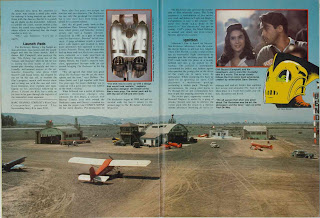
This might be too much arcana to most of you, but it’s worth noting because it also changes the way the magazine is designed. When you only had four pages of color in a row, that meant the designers would sometimes do interesting (or not interesting enough) things to start a feature article on a color page opposite a black-and-white page. (This has occasionally limited which page spreads I’ve scanned for display with these article writeups.) Now, increasingly, the feature articles all begin on two-page color spreads, which livens up the design options available to the art staff. The departments (Videolog, Tribute, From the Bridge, etc.) migrate to the B&W+1 pages, which also give the magazine a more traditional division between departments and the feature well.
Okay, all of that is probably far more interesting and significant to a magazine editor like me than it is to you.
Perhaps of more general interest is that in this issue, Starlog runs its first ad for the official Star Trek 25th Anniversary Special, a 100-page, all-color magazine celebrating the silver jubilee of the science-fiction series that inspired Starlog 15 years earlier. It’s a very nice publication, and it also must have brought in a good amount of money to the company; the 25th-anniversary special magazine would reportedly become a huge best-seller. Priced originally at $6.95, it can sell for multiples of that amount on eBay in 2010, though I see one seller who’s priced it at $1.40. The fool!
The rundown: Kevin Costner grabs the prime cover spot, dressed as Robin Hood, who’s a prince of thieves, as you probably know; and if that’s not enough for you, he’s also featured on the contents page. The Communications pages are filled with readers commenting on past coverage of Robin of Sherwood, Edward Scissorhands, Beauty & the Beast, and more, plus Mike Fisher’s Creature Profile features the Morlocks; David McDonnell’s Medialog reports on yet another Robin Hood project, this time for TV; and the Fan Network pages include Lia Pelosi’s directory of fan clubs and the convention calendar.
Drew Bittner previews Car Warriors, a new four-issue limited series Epic (Marvel) comic book; Kerry O’Quinn’s From the Bridge discusses a man whose passion and profession is designing the spaceships of today – airplanes; Bill Warren previews the science-fiction comedy Mom & Dad Save the World; in “Saracen Sentiments,” Jean Airey talks with actor Mark Ryan about his role as Nasir in Robin of Sherwood; William Wilson Goodson Jr. explains the origins and development of the Robin Hood lore; and Adam Pirani previews Kevin Costner's Robin Hood: Prince of Thieves.
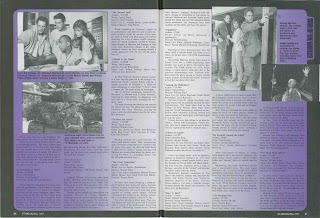
Marc Shapiro visits the set of The Rocketeer (in my opinion, one of the unappreciated gems of 1990s filmmaking); Daniel Dickholtz interviews Paige Turco, human star of Teenage Mutant Ninja Turtles II: The Secret of the Ooze; interplanetary correspondent Michael Wolf (with illustrations by George Kochell) looks at mutants in genre history; David Hutchison’s Videolog column announces Ghost and other genre releases; Peter Bloch-Hansen and Elyse Dickenson provide a complete episode guide to TV’s War of the Worlds; I swear to God there’s a classified ad that reads: “GIANT AMEBA! Grows hand-size, bigger. Unearthly, ‘desktop Blob.’ $5.00 guaranteed alive! ...”; and in his Liner Notes column, editor David McDonnell talks SF conventions and also says good-bye to long-time Starlog editorial staffer Eddie Berganza. Berganza would go on to an even longer career as a comics creator at DC.
“Over all, Robin Hood is established as Robin of the Village of Locksley. A yeoman, a freeborn man – neither noble nor peasant – he’s outlawed for poaching deer and killing a royal forester (in self-defense). And that’s where the adventures begin. Robin’s popularity comes from his humiliation of such figurees as the Sheriff and the Abbot, who were hated as tax collectors and enforcers of petty laws. While not a noble himself (in most legends), Robin Hood represents chivalry’s ideals, demonstrating personal honor, generosity, courage and loyalty to the Crown. To England’s commoners, an outlaw’s life, free of backbreaking farm labor and the daily duties to the lord of one’s manor, must have seemed like paradise.”
–William Wilson Goodson Jr., writer, “The Many Adventures of Robin Hood”
|
Hulk Hogan Conquers Starlog : Starlog #167, June 1991
Professional wrestler Hulk Hogan gets a cover spot this issue. He was one of the first big wrestlers to make the transition to other forms of entertainment (he’s the one who didn’t become governor of Minnesota).
Though this does bring to mind the early 1980’s jokey flirtation with professional wrestling in the pages of sister magazine Fangoria, it’s really nothing more than Starlog looking to sell some more copies at the newsstand with a big name. Still, editor David McDonnell notes in his editorial, “I never expected to put Hulk Hogan on the cover of Starlog. ... Here’s the truth of the matter: We had six cover possibilities. Then, two of the movies were rescheduled for later release. Two other interviews were delayed so they would happen after we absolutely had to go to press. And the TV movie perversely offered sparse pickings when it came to color photos. Which left the space comedy spoof. And it had these terrific pix of the alien monster created by Steve Johnson. So ...”
I’ll just note that Starlog’s publishing company at this time was also publishing a handful of professional wrestling magazines (Ringside Wrestling, Wrestling All-Stars, etc.), which reportedly at one time controlled more than 50 percent of the wrestling magazine market.
Starlog #167
80 pages (including covers)
Cover price: $4.50
On the inside front cover is an advertisement for The Rocketeer, which I mention only because I’m sure none of you even knew this movie existed. I saw it. Twice, I think. But I think my two tickets were the sole box office revenue earned by that film. But it’s a charming little adventure film that never got a Starlog cover story (yeah, that's right, Suburban Commando’s on the cover and Rocketeer got nada – it still hurts). But the Starlog team did do the movie justice with its sister magazine, Comics Scene, where it got a cover story (for the August 1991 issue, #20).

The rundown: Hulk Hogan’s Suburban Commando is on the cover (does that monster look to you like a Predator gone horribly wrong?); a Gremlins photo (sans any Gremlins) is featured on the contents page. The Communications section includes a letter from writer Jerome Bixby, who corrects an impression left by his interview in #164 and notes that Paramount turned down his sequel to his “Mirror, Mirror” episode of original Star Trek, plus readers comment on everything from First Men in the Moon to Beauty & the Beast to plans for the Sci Fi Channel, plus Mike Fish features the Body Snatchers in his Creature Profile comic; in his Medialog column, David McDonnell reports that Star Trek VI will indeed finally be made, but the declining box office of the films plus the aging cast “make it all but certain ... that this will be the last Star Trek film with the classic cast”; in his Videolog column, David Hutchison notes such recent genre releases as Predator 2, The Jungle Book, and Hooray for Horrorwood; and the Fan Network pages include Lia Pelosi’s directory of fan clubs and publications, plus the convention calendar.
It’s a sad day in science-fictionland, as Starlog devotes four pages to a Tribute section of obituaries: Lee Goldberg on James Bond screenwriter Richard Maibaum, Pat Jankiewicz on Beetlejuice and Top Gun screenwriter Warren Skaaren, Michael Mallory on stuntman and actor Tom Steele, Dan Scapperotti on actor Henry Brandon (Drums of Fu Manchu, The Searchers, Buck Rogers, and other classics), and Bill Warren on actor Keye Luke (most recently the mysterious merchant in the Gremlins movies, but perhaps most famously the “Number One Son” Lee Chan from the old Charlie Chan series); and in his From the Bridge column, Kerry O’Quinn gives an amusing account of his decision to take motorcycle lessons.
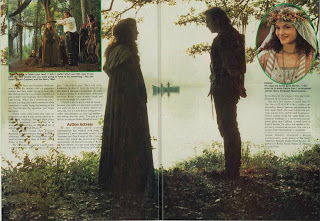
Adam Pirani interviews actress Mary Elizabeth Mastrantonio, who portrays Maid Marian in Robin Hood, Prince of Thieves (and who also discusses her less-than-enjoyable time acting in James Cameron’s The Abyss); Craig W. Chrissinger talks with fantasy writer Jennifer Robertson (Sword Breaker, The Song of Homana, etc.); Mark Burman profiles actor Patrick Bergin, who plays the lead in the TV movie The Adventures of Robin Hood (with a sidebar on the movie’s director, John Irvin); Bill Warren pens the cover story, a preview of the Hulk Hogan space comedy Suburban Commando; Karen Funk Blocher and Teresa Murray check in with former Doctor Who star Jon Pertwee, who tells a tale of the travails of working on that ultra-low-budget series, and in the process lifts the covers on British class warfare: “Due to budgetary considerations, high production values weren’t always in evidence – even with as fundamental a prop as the TARDIS console. According to Pertwee, the console once had to be altered for a scene in which he was to remove and replace a component. A man was sent to the set, armed with hammer and chisel. ‘Where do you want the hole, guv?’ the workman said. Pertwee indicated the appropriate place in the console, and advised the man to be careful. ‘Right,’ the man said, and struck the chisel. The blow sent a huge crack across the console panel, splitting it. ‘So, I hit him,’ Perwee says. But there was retribution. ‘All the unions immediately went out on strike. Fortunately, the producer backed me up.’”
Tom Weaver has a hat trick this issue, with three articles on the Creature from the Black Lagoon and its sequels – he interviews actress Julie Adams, who played the femme fatale in the original movie (and who notes that, despite enjoying her movie, “I didn’t really want to be in the sequels, to tell you the truth. So, I was happy that they didn’t come to me anyway”; he also talks with Ricou Browning, “the extraordinary swimmer who donned the scaly foam rubber suit of the Creature from the Black Lagoon” and who actually enjoyed working in the sequel; and he also talks with actress Lori Nelson, who was the femme fatale of Revenge of the Creature (plus a short sidebar on the late Leigh Snowden, the female lead of The Creature Walks Among Us); and David McDonnell’s Liner Notes column includes his smack my forehead why did I put Hulk Hogan on the cover comments, plus he notes some minor design changes to the magazine (such as spiffing up the department logos and moving around the glossy and non-glossy pages, as noted last issue).
“[The Abyss producers] also have this kind of autocratic way of filming – and I would like to say to all producers, ‘You hired me, you didn’t buy me. I have a right to know what my schedule is,’ and I do have that right because I haven’t actually signed over – because you do feel that after a while, you’ve actually signed over your free will, your time is not your own. They gave us one day a week off, but we stood for hour after hour after hour, and for days on end, and couldn’t leave this small town, because, ‘Well, we don’t know when we’ll need you.' ... I just think there are friendlier environments, and there’s a kind of a maturity in dealing with other people.”
–Mary Elizabeth Mastrantonio, actress, interviewed by Adam Pirani: “Princess of Thieves”
|
An Arnold-Sized 15th Anniversary Issue: Starlog #168, July 1991
Arnold Schwarzenegger is on the cover of Starlog, touting Terminator 2: Judgment Day, one of my favorite James Cameron films, though it's interesting to read Cameron in the cover story talking about how he has no new film lined up after this one, so if T2 isn't successful, his career could be trashed. A $100-million budget buster at the time of its making (well, few Cameron films arn't budget busters), it went on to become a huge success. It was also noted for its relentless action and violence, but I thought Cameron & Co. did a great job of making the film an anti-violence and anti-war film.
Plus it gave us a vengeful Linda Hamilton and little Edward Furlong, so it’s an all-around success.
Starlog #168
88 pages (including covers)
Cover price: $4.95
The cover price is jacked up to $4.95 from the usual $4.50 for this issue, but we don’t get the 100-page anniversary issues we got for the past decade. Instead, it’s only 88 pages. However, it does actually celebrate its anniversary, unlike most of the recent anniversary issues, which featured really just a larger issue (good issues, they were, just not chock full o’ anniversary goodness). This time, there’s a 10-page feature of photos and select quotes from the magazine’s history, plus a four-page gatefold poster of all of the previous covers of the magazine.
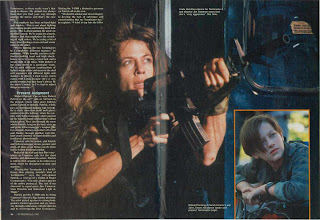 Editor David McDonnell notes in his editorial, “We could have chosen to review 167 issues of Starlog in this edition, remembering them all in great detail. Or print a section filled with anniversary messages from various celebrities – an idea I’ve always found self-congratulatory back-patting (and which we abandoned years ago). ... I didn’t want to do that. Many of you have been with us as readers for so long that you know our history. It’s as close as your bookcase (or mine) ... So rather than revel in the past, we’ve limited the celebration. Our special gatefold this issue re-presents all 167 Starlog covers. ... And in a long (but not that long) section, look to the voices of Starlog’s past, present and future as published over 15 years.”
The rundown: Arnold’s Terminator is on the cover; as noted above, there’s the eight-page fold-out poster of all previous covers, and there’s a two-page fold-out poster of Kevin Costner in Robin Hood, Prince of Thieves garb; comic-book versions of the Lost in Space folks are on the contents page; and in his Medialog column, David McDonnell alerts us that there will be an animated TV series spinoff of the Back to the Future films.
Interplanetary correspondent Michael Wolff, with illustrator George Kochell, looks at the depictions of Death (personified death, that is); Communications letters include Philip José Farmer commenting on William Wilson Goodson’s Robin Hood historical article from issue #166, readers complaining about the ugly creatures featured on the cover of issue #164, others exploring ideas raised in the recent Philip K. Dick interview or picking over the carcass of Beauty & the Beast, and more; Fan Network includes Lia Pelosi’s science-fiction fan club directory and the convention calendar; David McDonnell’s Videolog departs from his usual practice of listing newly released genre videos and instead explores the advent of 3-D home video; and Kerry O’Quinn’s From the Bridge column includes his experience in a college class that explores Star Trek episodes.
In “Voices of Starlog Past,” photos and quotes are reprinted from past issues of the magazine; Marc Shapiro visits the set of Terminator 2: Judgment Day; Edward Gross interviews Pen Densham, co-scriptor of Robin Hood, Prince of Thieves, which he admits was spawned by his idea of a “Robin Hood a la Raiders of the Lost Ark“; Kim Howard Johnson looks at the comics form of Lost in Space; and Edward Gross talks with writer Steven Carabatsos, who scripted original Star Trek episodes such as “Court Martial” and “Operation Annihilate.”
Gregory Mank talks with actor Hurd Hatfield and explores The Picture of Dorian Gray on film; Bill Florence profiles actor Harry Townes, a veteran of Star Trek (“The Return of the Archons”), The Brothers Karamazov (on which he worked with William Shatner), Screaming Mimi, and more; Stan Nichols interviews writer Michael Moorcock, who says that “Science fiction and rock ‘n’ roll were the two areas, as a kid, where there was no adult interest, no Establishment interest. I suppose I could dignify it all and romanticize it by saying it was revolutionary, or against the grain, and to some extent it was, but the fact is that every generation looks for something they can call their own”; and editor David McDonnell wraps it all up in his Liner Notes column by discussing the creation of this anniversary issue and listing a bunch of staffers, current and former.
“[For the film Dragon Seed,] I had these Chinese eyepieces; mine always came loose just before each shot. On location, in the San Fernando Valley, the loudspeaker would order, ‘Hatfield to the cameras!’ The first day, [costar Katharine] Hepburn – who terrified me – came out to watch this new young actor. I got on my Chinese water buffalo, and the buffalo, quite logically, went straight into the water, soaking my costume! I hit him with my antique Chinese flute – and broke it! And, of course, I knew nothing about continuity. In the scene on the old Chinese farm, I was to play my flute. In the master shot, I played the flute one way; in the medium shot, to be creative, I played it another way; in the close-up, a new way! Suddenly, there was this terrible pause. The director came up to me and said, ‘Have you been playing that flute the same way all morning?’ ‘Oh, no!’ I said very proudly. ‘I played it here, and this way, and this way ...’ Well, he threw his hat down, stamped on it, shouted implications and oaths... I had ruined most of the morning’s shooting! I thought, ‘Why’d I ever leave the theater?’”
–Hurd Hatfield, actor, interviewed by Gregory Mank: “Portrait in Gray”
|
Arnold's Back to Back: The Starlog Project, Starlog #169, August 1991
Starlog knows how to spot ‘em, sometimes. Sensing that Terminator 2: Judgment Day would be a big hit, the editors put T2 on the cover of the August issue, just as it was on the cover of the July issue. It even features the same character from the same movie, Arnold Schwarzenegger’s Terminator. (If the movie can be T2, can we just call Arnold’s character T? I suppose so, though then people might start calling him Mr. T, which would just be disastrous.)
Starlog also has a horse in this race. This issue it announces that it’s publishing the official T2 licensed movie magazine. $4.95, all color and 68 pages (if I remember correctly). I’m just guessing that it will make a ton of money for the company.
Few people thought the studio would recoup the then-record $100 million cost of producing the film, but of course T2 went on to become a smash hit and just the latest in a long line of James Cameron near-death career experiences.
Starlog #169
84 pages (including covers)
Cover price: $4.95
Interesting, this: This issue’s cover price is $4.95, the same as the previous issue, which was the extra-pages anniversary edition. Is it a permanent cover price hike? No, but oddly several issues will carry this new cover price, after which the cover price will drop back down to $4.50 and the page count will drop again from 84 to 80. Why the price spike? Was it a trial to see if readers were willing to page $5 for a copy of the magazine? Was it an attempt to get some greater lucre from the summer film-going season? Who knows?
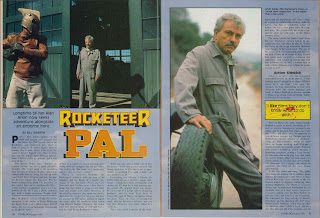
The rundown: The Schwarzemeister’s on the cover, again; meanwhile, Doctor Who’s Sophie Aldred is featured on the contents page; in the Communications section, Star Trek Research Consultant Richard Arnold responds to previous letters on Star Trek, a reader responds to Richard Arnold’s letter (no, not this one, but rather Arnold’s letter in Starlog #161), and other readers comment on Star Trek games, scripts, and more, thus giving Mr. Arnold a reason to write a third letter, if he's up to it, plus Mike Fisher’s Creature Profile comic features Them!; in his Medialog column, David McDonnell notes that the previously announced Starlog: The Science Fiction Universe television project is “on hold”; in his Videolog column, David Hutchison announces Woody Allen’s Alice, Edward Scissorhands, and other genre releases; and the Fan Network pages include Lia Pelosi’s directory of fan clubs and publications, plus the convention calendar.
The great writer Roald Dahl is interviewed by Tom Soter, and he discusses working on two adaptations of Ian Fleming works: You Only Live Twice and Chitty Chitty Bang Bang (and he has some pretty tough words for Sean Connery, who he thinks got too full of himself when he decided to walk away from the Bond role: “He was a very foolish fellow to get bored by Bond because it made him. ... I don’t think Sean behaved very well on this film. ... No, I don’t think Sean Connery’s a complicated creature at all. he’s an absolutely straightforward, rather dull Scotsman.”); in a two-page Tribute section, Marc Shapiro writes actor Kevin Peter Hall’s obituary, Kim Howard Johnson does the honors for James Bond titles designer Maurice Binder, and Ian Spelling remembers writer and lyricist Howard Ashman (The Little Mermaid); and Kerry O’Quinn’s From the Bridge relates his injury and surgery after crashing his motorcycle (which he discussed pre-crash in #167).
Marc Shapiro interviews Terminator 2: Judgment Day actor Arnold Schwarzenegger, who admits that "acting out the action stuff and the ballsy parts was not a difficult thing for me to do. The most difficult scenes were the ones where I had to respond to questions or rattle off dialogue and come across as believable as a machine”; Bill Warren talks with veteran actor Alan Arkin, who discusses The Rocketeer, as well as The Seven-Percent Solution, The Return of Captain Invincible, and other films.
Warren also visits the set of Bill & Ted’s Bogus Journey; Kyle Counts checks in with screenwriter Joe Gannon about Solar Crisis, a film he wrote but that was then drastically rewritten by others; David Hirsch profiles composer Gerald Fried about his work on the original Star Trek TV series; John B. McLay examines new original Doctor Who novels; in “Tenctonese Funnies,” Edward Gross previews the new comic books based on the canceled Alien Nation television series; Peter Weller exits the metal copsuit and is replaced by actor Robert Burke for RoboCop 3, the set of which Kim Howard Johnson visits; and David McDonnell’s Liner Notes column touts various new releases from the wonderful world of Starlog magazines, including the aforementioned Terminator 2: Judgement Day Official Movie Magazine, which includes designs and production illustrations “you may not see published anywhere else. Truly amazing!”
“When I first heard the primary notion that some part of the movie [Solar Crisis] would take place inside the Sun, my heart sank. I love science fiction, but I love science fiction that’s based on degrees of reality, even if that reality is warped in some way. My first feeling was that this [plotline] was so implausible, you could never really bring the audience with you, as it were. But then, as I thought about it, I realized it was implausible, but not impossible. In that distinction, I found I could believe in the story.”
–Joe Gannon, screenwriter, interviewed by Kyle Counts: “Flare-Up”
|
Bill & Ted's Bogus Sequel: The Starlog Project, Starlog #170, September 1991
Bill and Ted return to the big screen with Bill & Ted's Bogus Journey, the sequel to the 1989 quirky surprise hit Bill & Ted's Excellent Adventure. The sequel was originally called Bill & Ted Go to Hell, but that title was apparently too much for the timid souls who run the film studio, so it was changed to the new bogus Bogus title.
As for the film itself ... well, when was the last time you popped it into the DVD player and watched it all the way through? Within the last 15 years? Ever?
That tells you all you need to know.
Starlog #170
84 pages (including covers)
Cover price: $4.95
Odd classified ad of the month: "THE ZOMBIE ARMY – The world's first Zombie Combat Rock Music Video Contest! 'Two thumbs OFF!' BIG SHOUT MAGAZINE. The U.S. ARMY battles Zombies head to dead! YOU could win a real Zombie Army surplus Jeep used in the movie! $28. check or MO to ..." Wonder if they got any entries.

The rundown: Alex Winter and Keanu Reeves pose with Bill Sadler (as Death) on the cover; meanwhile, because you can never get enough Terminator, Arnold Schwarzenegger is featured on the contents page; Communications letters include a reader complaining about science-fiction conventions and the state of genre films, another pleading to resurrect Battlestar Galactica, and more, plus Mike Fischer's creature profile is the cyborg you can't get enough of, the Terminator; and David McDonnell's Medialog column notes that not only is there a Bill & Ted animated series, but Fox is launching a live-action Bill & Ted series, proving that you can, in fact, get enough of Bill & Ted.
Michael Wolff and illustrator George Kochell examine time travel in science fiction; Bruce Gordon returns with another popular examination of the implications of the Back to the Future movies with "The Other Marty McFly Rides West"; the Fan Network pages include David Hutchison's announcement of New York's Fifth Annual Summer Festival of Fantasy, Horror & Science Fiction (which was programmed in part by Starlog contributor Tom Weaver), Lia Pelosi's fan club and publications directory, plus the convention calendar; David Hutchison's Videolog column announces a string of new releases of old Outer Limits, Amazing Stories, and Twilight Zone episodes; Kerry O'Quinn's From the Bridge column explains why heaven is in space; Bill Warren pens the cover story, talking with Bill & Ted stars Alex Winter and Keanu Reeves; and Marc Shapiro manages to interview a multi-tasking Terminator 2 director James Cameron.
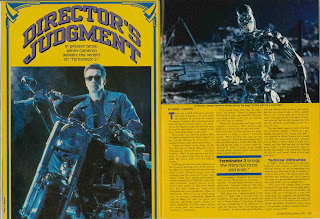
Will Murray visits the set of Free-Jack, the movie that dares to bring together Mick Jagger and Emilio Estevez; Bill Wilson previews the Back to the Future ride at Universal Studios Florida; Edward Gross looks at the Quantum Leap comics; Marc Shapiro profiles actor Robert Patrick, who portrays the T-1000, the Terminator so advanced it can speak English without an accent; Edward Gross examines the original plans for Star Trek IV: The Voyage Home, which involved traveling back in time ... to meet Eddie Murphy (oh, and Spock had a baby with Saavik); Larry S. Barbee contributes his first article to the magazine, a look at "Shada," the only Doctor Who production to have been begun but left unfinished (due to a strike by the BBC's technical workers); in part one of a multi-part article, Mark Phillips provides "A Brief History of The Time Tunnel"; and in his Liner Notes column, editor David McDonnell goes time-tripping.
"One of the things we had in our earlier drafts [for Star Trek IV] that they took out was what happened when they first went through time. Instead of that horrible time sequence that looks like Russian science fiction, we had them using the slingshot effect around Jupiter and Mars. Also, when they first appeared in the 20th century, they were in a fog, and as they lowered, the monitors picked up all of this cheering and applause. As they come out of the fog, they find themselves over a Super Bowl game and everyone thinks it's a halftime show. Then, they cloak and disappear."
–Peter Krikes, writer, interviewed by Edward Gross: "The First Voyage Home"
|
x
x
x
x x |
|
|
